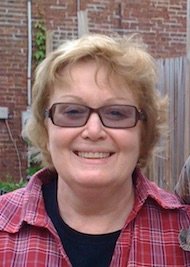
Mary McTamaney
By Mary McTamaney
During this past winter, the Newburgh Historical Society’s volunteers have been inspecting and sorting many collection items that are not out on regular display. In cabinets and drawers around their headquarters in the old Crawford House on the corner of Montgomery and Clinton streets, are many things saved for the story they illustrate. I came across one this month when a group of archival flag boxes were inventoried (the acid-free ones folded, as precious flags are, in triangles). When I saw the box labeled “Alsdorf,” I remembered its story.
Within this month dedicated to Black History, it’s a good time to share that story.
In the fall of 1950, a short and slender gentleman handed his precious family flag over to the trustees of the historical society. The flag was twice his height and also dwarfed the three people accepting it. It had hung on the wall of the Alsdorf Music School at 93 Liberty Street, which was closing after a century of service to Newburgh. The gentleman saying farewell to his family heirloom was Mr. Ulysses Alsdorf, the last member of his talented family to operate the music academy. He was the remaining musician, composer and teacher in a family of immense talent.
Alsdorf Academy taught generations of Newburghers – both adults and children – the art of instrumental music and dance. His father had filled that role before him and so had his grandfather. His brothers were equally talented and renown. As the twentieth century passed its mid-point, Ulysses was the sole musician left carrying on the legacy and he knew he must close his music school as he approached 80 years of age.
The walls of 93 Liberty Street were full of the silent echoes of instrumental concerts and lively dance steps, of the squeeks and flats of violins and trumpets being tried by classes of Newburgh children, of the robust rhythms of each youth orchestra finally perfecting their performance. Ulysses’ brother Charles and his wife Lugenia had led a Wednesday Night Dance Club for adults since they were the family members with the strong talent for learning and sharing all the latest dances. Charles choreographed dance routines for performances all around the Hudson Valley. His brother Simon also taught instrumental music, played first violin in regional orchestras and was the craftsman who could repair and rebuild instruments of all types.
The three Alsdorf brothers traced their musical roots back three generations to a grandfather, George, who learned to dance and fiddle while enslaved up in Ulster County. When manumission laws finally freed him, he came south to the port village of Newburgh where there was more opportunity to use his talents.
He began teaching dance at the big United States Hotel. He played violin with local bands. He formed the first Alsdorf Orchestra and played a July 4th concert on the steps of the old courthouse downtown to a large crowd – two decades before Lincoln’s Emancipation Proclamation began to encourage respect and equal rights. Among George’s children was Dubois Alsdorf who bought land on Washington Street where several of the family operated small businesses like catering and hairdressing. Dubois and his wife Mary began a music school there in earnest near the intersection of Mill Street. His sons carried on the family profession and built the handsome brick academy across from Washington’s Headquarters in 1915 to serve a growing clientele.
The precious flag that the Alsdorfs bought to hang at their Liberty Street Academy is preserved. So is some of the popular sheet music that Ulysses composed in the early 20th century. In addition, a Liberty Street friend and neighbor, Agnes Moglia, rescued from the house after Ulysses’ death in 1952, several scrapbooks that Simon and Ulysses Alsdorf created and kept. The old books tell about the Newburgh that the Alsdorfs knew and navigated as an African American family in a city not yet very multi-racial. The entire set of Alsdorf scrapbooks are preserved at the Newburgh Free Library.
This Thursday evening, February 22 at 7 p.m., City Historian Mary McTamaney will showcase the big Alsdorf Academy flag and a couple of the family scrapbooks at this year’s first Collections and Cocktails at Crawford House lecture series. All are welcome. There is no admission price but contributions to the historical society are appreciated.